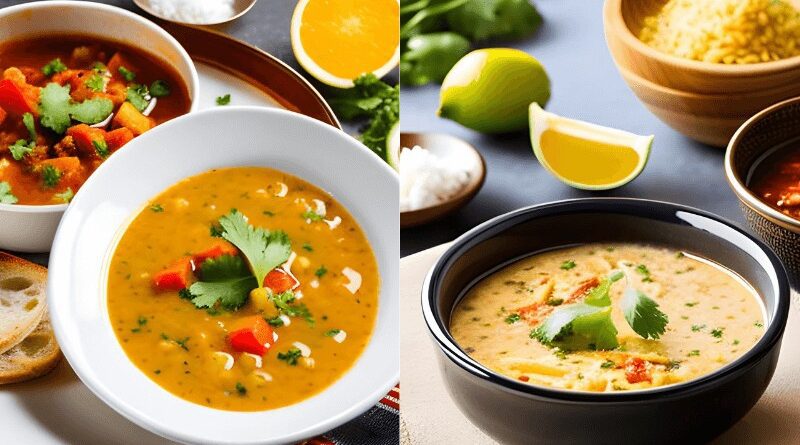Traditional Turkish Soups: Embarking on a Journey of Flavor with Turkish Soups
Contents
Traditional Turkish Soups
It wouldn’t be an exaggeration to say that the rich heritage of Turkish cuisine is a gastronomic treasure trove, brimming with diversity and flavors. One of the most distinctive components of this culinary tapestry is undoubtedly traditional Turkish soups. Soup, an indispensable part of Turkish tables, warms our hearts and souls, especially on cold winter days. In this article, under the keyword “Turkish Soups,” we will take a closer look at the unique varieties of Turkish soups on a journey of flavors.
The Legacy of Turkish Cuisine: Turkish Soups
In Turkish cuisine, soups are more than just meals; they are cultural symbols. Evolving and enriching over thousands of years, the array of soup varieties can vary by region. Yogurt-based soups, meaty soups, vegetable-based soups, and numerous other variations reflect the rich tapestry of Turkish cuisine. Moreover, Turkish soups hold value not only in terms of taste but also for their health benefits. The natural ingredients and spices they contain not only tantalize the taste buds but also nourish the body.
Notable Turkish Soups
While Turkish cuisine boasts a wide repertoire of soups, certain ones stand out among the rest. Lentil soup, blending the satisfying taste of red lentils, and tarhana soup, adorned with the unforgettable aroma of fermented tarhana powder, grace our tables. Tripe soup, known as “işkembe,” and yogurt soup, “yoğurt çorbası,” also proudly represent the distinct flavors of Turkish cuisine. Additionally, the indispensable ezogelin soup, a blend of red lentils and bulgur harmonized with spices, offers a feast for both the eyes and the stomach, especially during the winter months.
Popular Traditional Turkish Soups
Traditional Turkish soups indeed carry a rich culinary legacy. Since you haven’t specified which soups you would like to discuss, let me provide you with details about some popular traditional Turkish soups and their characteristics:
Lentil Soup:
Perhaps the most renowned Turkish soup, prepared using red or green lentils. Enriched with onions, flour, tomato paste, and spices, it’s often served with a touch of lemon.
Red Lentil Soup Recipe Green Lentil Soup Recipe
Tarhana Soup:
Made from a mixture of fermented and dried yogurt, flour, and vegetables. This soup is favored during the winter months and may contain vegetables, sometimes meat, or yogurt.
Tarhana Soup Recipe
Yogurt Soup (“Çorba Aşı”):
Made by blending yogurt, flour, and water, with added spices like mint and salt. Optionally, it can be served with mint-infused red pepper-flavored oil.
Ezogelin Soup:
This soup, named after a story, combines red lentils, rice, and bulgur. It’s enriched with tomato and pepper paste, as well as various spices.
Tripe Soup:
Often consumed in the morning, prepared using tripe, garlic, flour, and yogurt. It’s garnished with vinegar and red pepper flakes before serving.
Wedding Soup:
Commonly served at weddings, made from meat broth, yogurt, flour, and eggs. It’s garnished with melted butter and mint.
Chicken and Vermicelli Soup:
This light and tasty soup consists of chicken broth, vermicelli, and spices. It’s often flavored with lemon.
Potato Soup:
Prepared with vegetables like potatoes, onions, and carrots, this soup boasts a creamy texture. It’s a favorite among children as well.
Yogurt and Rice Soup (“Yayla Çorbası”):
A yogurt-based soup made with rice or small pasta. Served with fresh or dried mint.
Trotter Soup (“Paça Çorbası”):
Typically consumed during breakfast, similar to tripe soup but with a thicker consistency, using a gel-like substance obtained from the lower part of the tripe.
These are just a few examples;
Turkish cuisine is teeming with a variety of flavorful soups. Each soup offers its unique ingredients and preparation methods.
In Conclusion
Traditional Turkish soups, as part of the richness of Turkish cuisine, stand out not only for their taste but also their nutritional value. Each soup is a reflection of thousands of years of culinary tradition, showcasing the diversity of Turkish cuisine. On this flavor journey, under the keyword “Turkish Soups,” we invite anyone eager to explore the unique flavors of Turkish traditional soups. The soup examples we’ve provided in this article are merely the visible part of the iceberg. Delving into the depths of Turkish cuisine, experiencing the myriad soup flavors, will not only enrich our culinary culture but also delight your palate.
